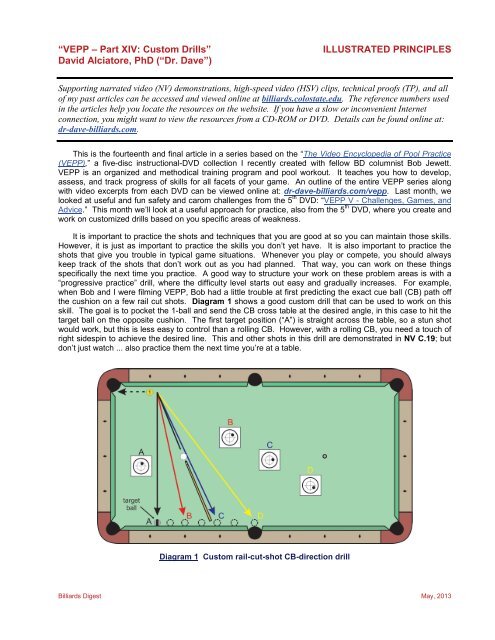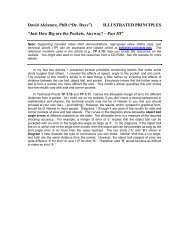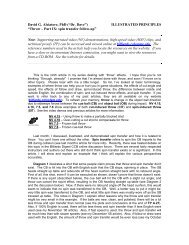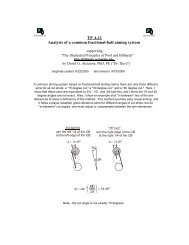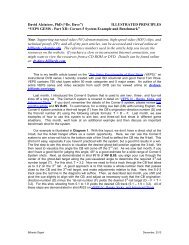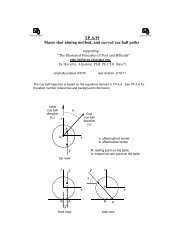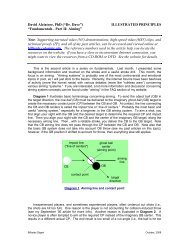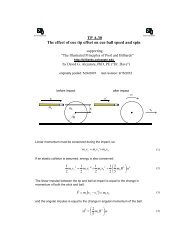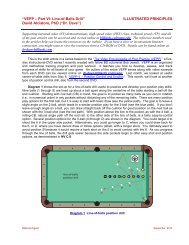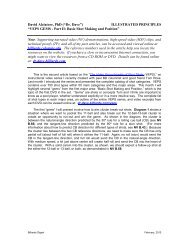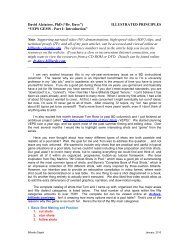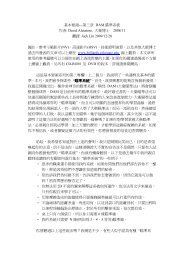VEPP – Part XIV: Custom Drills - Illustrated Principles of Pool and ...
VEPP – Part XIV: Custom Drills - Illustrated Principles of Pool and ...
VEPP – Part XIV: Custom Drills - Illustrated Principles of Pool and ...
You also want an ePaper? Increase the reach of your titles
YUMPU automatically turns print PDFs into web optimized ePapers that Google loves.
“<strong>VEPP</strong> <strong>–</strong> <strong>Part</strong> <strong>XIV</strong>: <strong>Custom</strong> <strong>Drills</strong>” ILLUSTRATED PRINCIPLES<br />
David Alciatore, PhD (“Dr. Dave”)<br />
Supporting narrated video (NV) demonstrations, high-speed video (HSV) clips, technical pro<strong>of</strong>s (TP), <strong>and</strong> all<br />
<strong>of</strong> my past articles can be accessed <strong>and</strong> viewed online at billiards.colostate.edu. The reference numbers used<br />
in the articles help you locate the resources on the website. If you have a slow or inconvenient Internet<br />
connection, you might want to view the resources from a CD-ROM or DVD. Details can be found online at:<br />
dr-dave-billiards.com.<br />
This is the fourteenth <strong>and</strong> final article in a series based on the “The Video Encyclopedia <strong>of</strong> <strong>Pool</strong> Practice<br />
(<strong>VEPP</strong>),” a five-disc instructional-DVD collection I recently created with fellow BD columnist Bob Jewett.<br />
<strong>VEPP</strong> is an organized <strong>and</strong> methodical training program <strong>and</strong> pool workout. It teaches you how to develop,<br />
assess, <strong>and</strong> track progress <strong>of</strong> skills for all facets <strong>of</strong> your game. An outline <strong>of</strong> the entire <strong>VEPP</strong> series along<br />
with video excerpts from each DVD can be viewed online at: dr-dave-billiards.com/vepp. Last month, we<br />
looked at useful <strong>and</strong> fun safety <strong>and</strong> carom challenges from the 5 th DVD: “<strong>VEPP</strong> V - Challenges, Games, <strong>and</strong><br />
Advice.” This month we’ll look at a useful approach for practice, also from the 5 th DVD, where you create <strong>and</strong><br />
work on customized drills based on you specific areas <strong>of</strong> weakness.<br />
It is important to practice the shots <strong>and</strong> techniques that you are good at so you can maintain those skills.<br />
However, it is just as important to practice the skills you don’t yet have. It is also important to practice the<br />
shots that give you trouble in typical game situations. Whenever you play or compete, you should always<br />
keep track <strong>of</strong> the shots that don’t work out as you had planned. That way, you can work on these things<br />
specifically the next time you practice. A good way to structure your work on these problem areas is with a<br />
“progressive practice” drill, where the difficulty level starts out easy <strong>and</strong> gradually increases. For example,<br />
when Bob <strong>and</strong> I were filming <strong>VEPP</strong>, Bob had a little trouble at first predicting the exact cue ball (CB) path <strong>of</strong>f<br />
the cushion on a few rail cut shots. Diagram 1 shows a good custom drill that can be used to work on this<br />
skill. The goal is to pocket the 1-ball <strong>and</strong> send the CB cross table at the desired angle, in this case to hit the<br />
target ball on the opposite cushion. The first target position (“A”) is straight across the table, so a stun shot<br />
would work, but this is less easy to control than a rolling CB. However, with a rolling CB, you need a touch <strong>of</strong><br />
right sidespin to achieve the desired line. This <strong>and</strong> other shots in this drill are demonstrated in NV C.19; but<br />
don’t just watch ... also practice them the next time you’re at a table.<br />
Diagram 1 <strong>Custom</strong> rail-cut-shot CB-direction drill<br />
Billiards Digest May, 2013
After practicing <strong>and</strong> succeeding with the first shot in Diagram 1 several times, progressively advance the<br />
target ball up table to develop a feel for how you need to adjust speed <strong>and</strong> spin to send the CB along each <strong>of</strong><br />
the desired lines. For target position “B,” you can still use a rolling CB, but you need to add more sidespin.<br />
The amount <strong>of</strong> sidespin required will vary some with table conditions. The CB direction will also vary a little<br />
depending on how much you might cheat the pocket, which changes the cut angle slightly. Sidespin makes<br />
the shot more difficult because you need to be able to adjust for the squirt <strong>and</strong> swerve that comes with using<br />
english. For information <strong>and</strong> demonstrations for how to compensate for squirt <strong>and</strong> swerve, see the “aim<br />
compensation” FAQ page on my website. For target position “C,” Bob used nearly maximum english, still<br />
allowing the CB to roll. For target position “D,” Bob used near maximum sidespin with slight draw to create<br />
drag which increases the effect <strong>of</strong> the sidespin. See how high you can send the CB up table using draw,<br />
sidespin, <strong>and</strong>/or pocket cheating. The side pocket was close to the limit on my table.<br />
Diagram 2 shows another example custom progressive drill that focusses on a common “problem shot”<br />
for many people. The goal is to pocket the 2-ball <strong>and</strong> send the CB directly across the table a controlled<br />
amount. We have a printable target available on the <strong>VEPP</strong> website that you can cut out to serve as the CB<br />
goal position. Start with the target one diamond <strong>of</strong>f the long rail, <strong>and</strong> progressively move it farther away with<br />
each success. The CB is always shot from the same spot, across from the side pocket a diamond <strong>of</strong>f the rail.<br />
We have a demonstration <strong>of</strong> the drill in NV C.20. Because there is a slight cut angle on this shot, a stun shot<br />
would send the CB along the tangent line, which would send the CB a little up table. One approach to having<br />
the CB head straight across table instead is to make sure the CB has a slight amount <strong>of</strong> forward roll when it<br />
reaches the object ball. In the video, for the starting target position, Bob uses a center-ball hit at medium<br />
speed to accomplish the task. The CB picks up a little forward roll by itself on the way to the 2-ball.<br />
Diagram 2 <strong>Custom</strong> stun-across-the-table drill<br />
As you add more speed to send the CB to the more-distant target positions, you will need to raise the tip<br />
a little to allow the CB to develop slight forward roll. As we demonstrate in NV C.20, as long as you end up<br />
within a h<strong>and</strong> span <strong>of</strong> the target, call it good. This drill is challenging because you need to be accurate with<br />
the exact cut angle <strong>of</strong> the shot (i.e., you can’t cheat the pocket too much), the amount <strong>of</strong> CB forward roll at<br />
impact needs to be fairly precise, <strong>and</strong> the speed needs to be good to reach the target distance. Try out the<br />
drill <strong>and</strong> practice sending the CB to each <strong>of</strong> the target positions shown in the diagram. Even with the<br />
relatively small cut angle <strong>of</strong> the shot, it is still easy to get the CB across the entire table width. The key is to<br />
be accurate <strong>and</strong> consistent at the different distances so you will be able to control the CB when needed in a<br />
game situation.<br />
Billiards Digest May, 2013
Again, keep track <strong>of</strong> shots you miss during matches <strong>and</strong> run-out drills <strong>and</strong> develop <strong>and</strong> practice your own<br />
custom drills like the examples above. With practice, hopefully you won’t miss those same shots again the<br />
next time them come up in a match. I hope you have enjoyed <strong>and</strong> benefitted from my series <strong>of</strong> articles<br />
featuring drills from the “Video Encyclopedia <strong>of</strong> <strong>Pool</strong> Practice (<strong>VEPP</strong>).”<br />
Good luck with your game,<br />
Dr. Dave<br />
normal video<br />
PS:<br />
NV C.19 - <strong>Custom</strong> drills - rail cut shots with english, from <strong>VEPP</strong> V<br />
NV C.20 - <strong>Custom</strong> drills - stun across the table with rail cut shots, from <strong>VEPP</strong> V<br />
• I know other authors <strong>and</strong> I tend to use lots <strong>of</strong> terminology, <strong>and</strong> I know not all readers are totally<br />
familiar with these terms. If you ever come across a word or phrase you don’t fully underst<strong>and</strong>,<br />
please refer to the online glossary on my website.<br />
Dr. Dave is author <strong>of</strong> the book, DVD, <strong>and</strong> CD-ROM: “The <strong>Illustrated</strong> <strong>Principles</strong> <strong>of</strong> <strong>Pool</strong> <strong>and</strong><br />
Billiards,” <strong>and</strong> co-author <strong>of</strong> the DVD Series: “Video Encyclopedia <strong>of</strong> <strong>Pool</strong> Shots (VEPS)” <strong>and</strong><br />
“Video Encyclopedia <strong>of</strong> <strong>Pool</strong> Practice (<strong>VEPP</strong>).”<br />
Billiards Digest May, 2013


